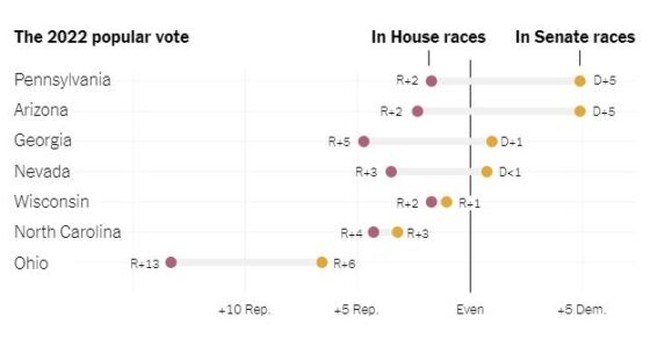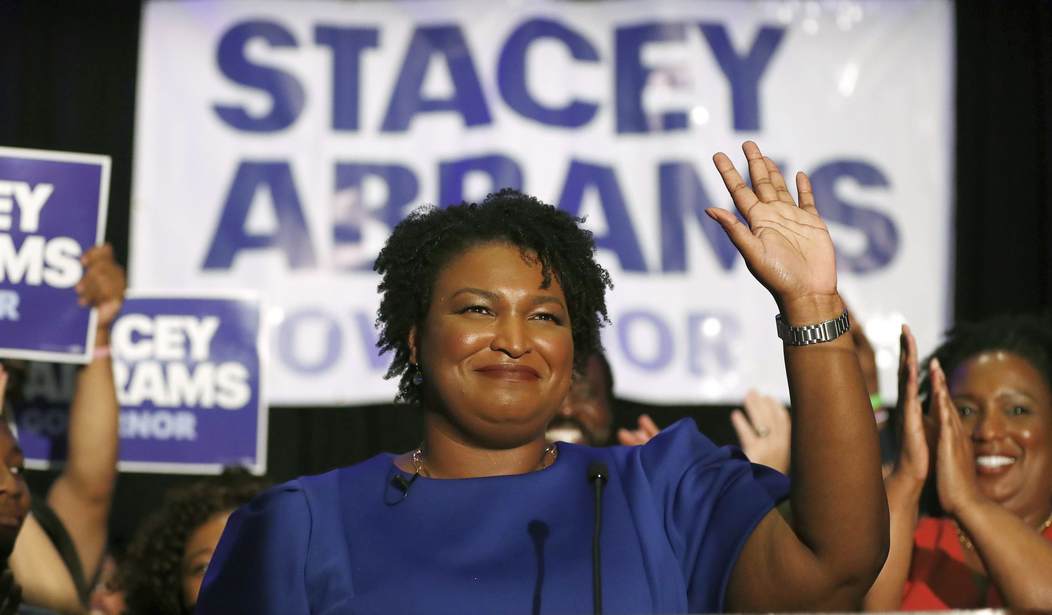Now that the situation in the House is finally settled, we can look out over the 2022 landscape and try to make sense of the big picture. Over at the NY Times, Nate Cohn has a story today titled “2022 Review: How Republicans Lost Despite Winning the Popular Vote.”
Here’s a figure about the 2022 midterm elections that might surprise you: Republicans won the national House popular vote by three percentage points — 51 percent to 48 percent. They still won by two points after adjusting for races in which only one major party was on the ballot.
Yes, that’s right: Republicans won the popular vote by a clear if modest margin, even as Democrats gained seats in the Senate and came within thousands of votes of holding the House…
…if the Republicans had run seven points better than Joe Biden’s 2020 showing in every state and district, as they did nationwide. They would have picked up 21 seats in the House, about the number many analysts expected. They also would have easily won the Senate, flipping Arizona, Nevada, Georgia, and holding Pennsylvania.
Cohn emphasizes the point that GOP strength in this election wasn’t a phantom or a result of overperforming in one state (Florida) or of Democrats deciding to stay home in California. The GOP had real, widespread strength including in those critical battleground states:
Consider, for instance, that Republican candidates won the most votes for U.S. House in all four of the crucial Senate states where Republicans fell short: Pennsylvania, Arizona, Georgia and Nevada.
Or, put differently: Republicans would have won the Senate, and fairly decisively, if only the likes of Dr. Mehmet Oz or Herschel Walker had fared as well as Republican House candidates on the same ballot.
This chart created by Cohn sort of sums up the reality in 2022. The purple dots show how the GOP performed in House races in each state. The yellow dots show how the GOP did in the Senate races:

Lots of voters who checked the box for a GOP House candidate chose not to do so for a GOP Senate candidate. And this leads pretty clearly to the argument about candidate quality. Over at his Substack site, Matt Yglesias argues there’s an obvious takeaway from these results: Swing voters are real. Put another way, you can’t win races by winning the turnout battle alone, you also have to win persuadable voters who could vote either way.
Now that all the races are resolved, the 2022 midterms were pretty clearly the most catastrophic defeat yet for mobilization theory. As Nate Cohn explained in detail in the New York Times last Thursday, Republicans decisively won the turnout battle in key states, even while losing the preponderance of important races…
Democrats won key races by persuading a small but nonzero number of Republicans to vote for them.
Yglesias notes that, despite her loss, some progressives were still praising Stacey Abrams and her theory that you could organize your way to victory:
…a lot of people on the left are very dug-in on the bigger picture conceptual argument about mobilization because they believe mobilization theory gives them license to practice irresponsible, undisciplined politics. That’s how we ended up with this slightly bizarre urge to give credit to Stacey Abrams (who lost her Georgia statewide race rather badly) for the fact that Raphael Warnock managed to get more votes than his opponent.
https://twitter.com/PamKeithFL/status/1600349274100756480
Stacey Abrams didn’t organize her way to victory. As I’ve pointed out before, voters in Georgia were turned off by the fact that she refused to concede the 2018 election. But Raphael Warnock still won his race and he did it through persuasion:
Warnock’s campaign manager, Quentin Fulks, describes their deliberate efforts to court these voters.
“There could have been other campaign operatives or another campaign that could have said, ‘OK, Herschel Walker has all this baggage, so we’re just going to run to the left and just try to turn out as many of our voters and just let Republicans eat their own,” he told Bloomberg’s Sahil Kapur. “We didn’t do that.”
All of his post is written from the perspective of Democrats/progressives who want to win future races, but the arguments Yglesias is making apply just as much to Republicans and conservatives. The way to win isn’t to organize the base and ignore the middle. That’s the Stacey Abrams approach and it doesn’t work. The way the right can win is to appeal to persuadable independents and Democrats in the middle.
I think it’s fair to say a lot of Republicans nationwide did that pretty well with a focus on inflation, the economy, crime, etc. That’s why the GOP won a bigger percentage of the vote and was able to flip the House. But some Republican candidates, particularly on the Senate side, were not as appealing to those in the middle and that mattered. It’s why the GOP failed to take control of the Senate.
Does this apply to Gov. DeSantis big blowout win in Florida, i.e. the one state where the red wave really did hit? I think it does. DeSantis delivered a lot of culture war red meat to the base this year, but he also delivered a pretty solid handling of a very serious hurricane about a month before the election. He got the power back on and got the causeways rebuilt. He was barnstorming the worst hit areas and putting in a lot of effort. He was on the job for everyone, not just GOP voters. Even when President Biden toured the area, DeSantis didn’t go for a red meat confrontation, he kept it civil and just did his job. People saw all of that and the result was a blowout.
That’s the path forward for both Republicans and Democrats. You can please the base to get them on your side but you also have to be civil and effective at governing to hold on to the persuadable voters in the middle who could go either way. The question in 2024 is going to be which party learns that lesson and which one is still relying on a strategy that tries to whip up the base and ignore the center.







Join the conversation as a VIP Member